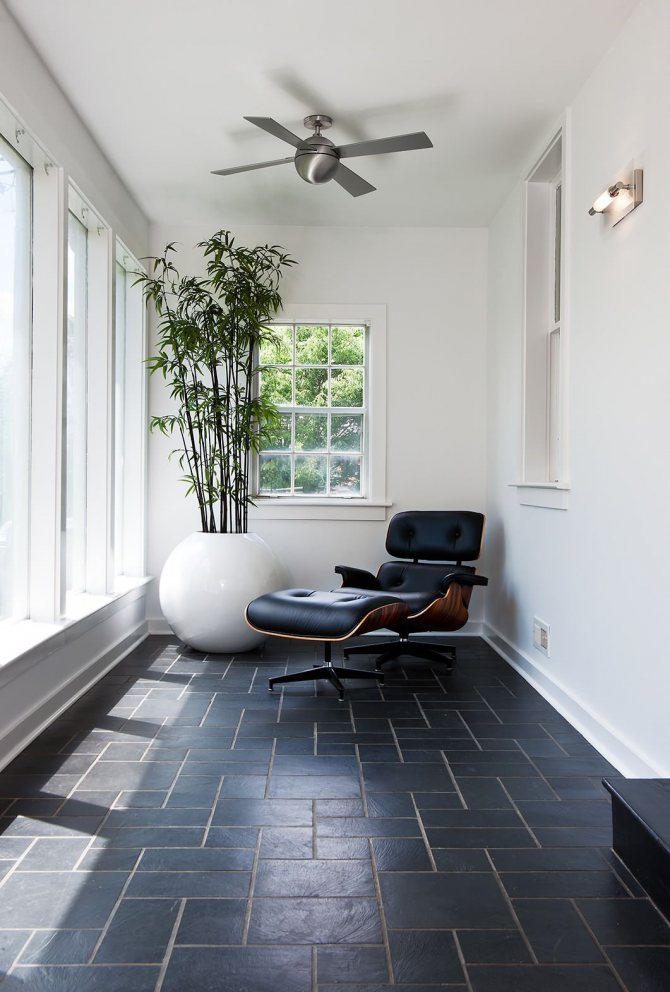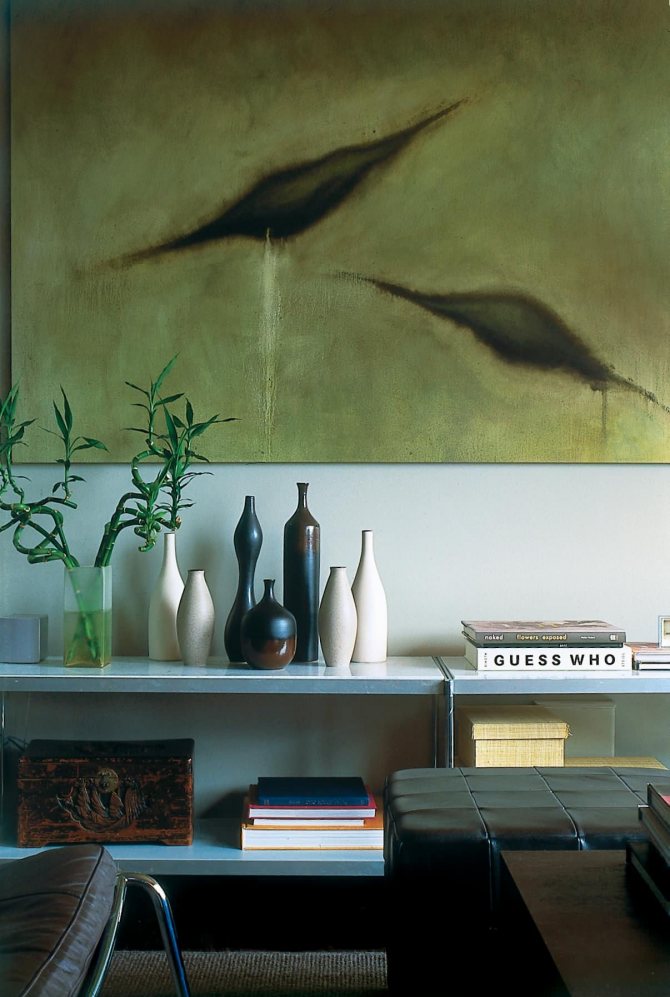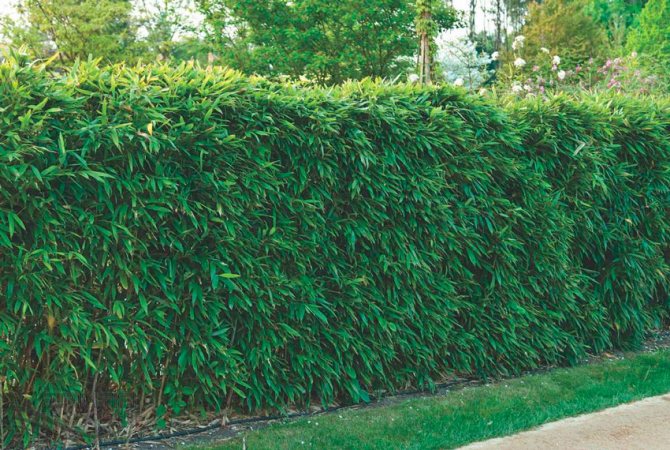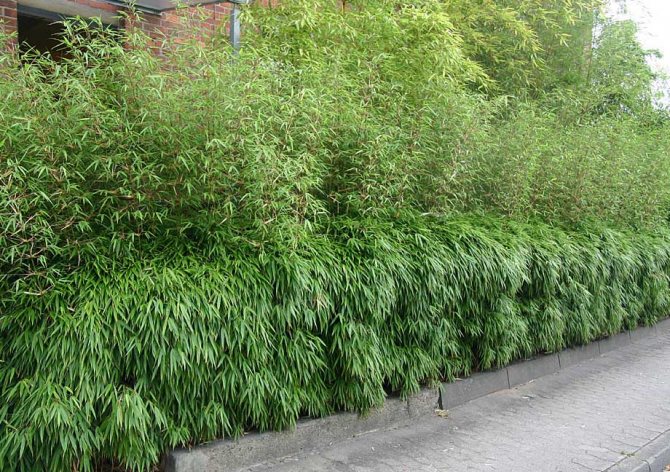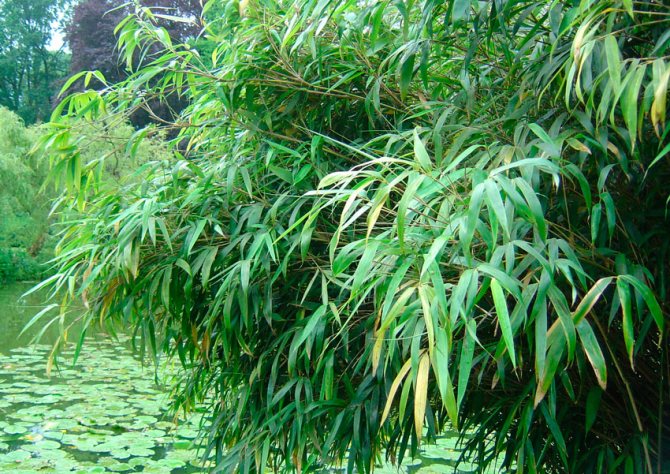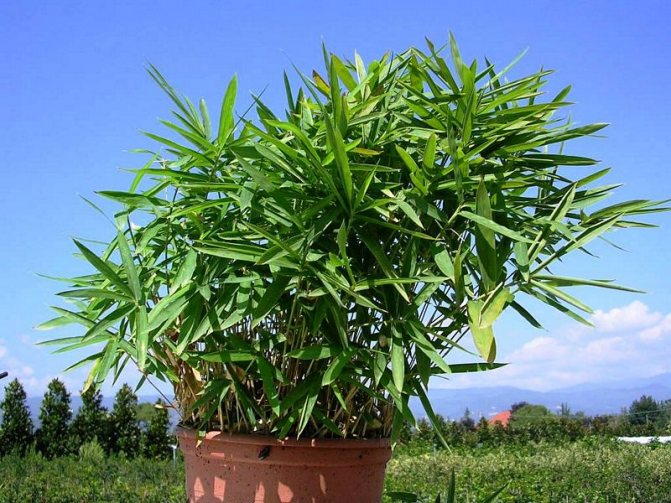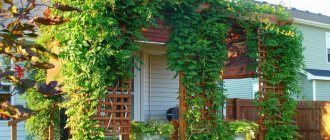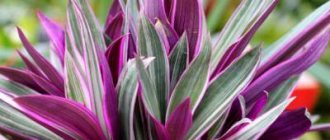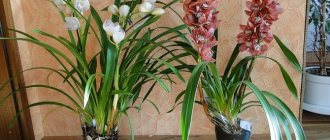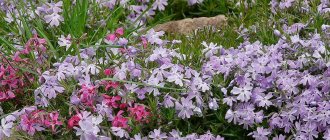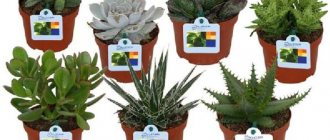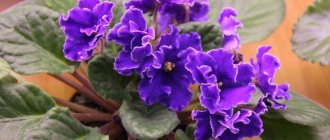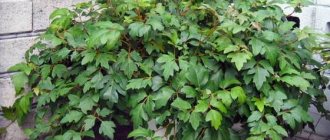Home | Useful articles | Learning how to properly grow indoor bamboo
Date: 25 March 2019
Comments: 0
5 / 5 ( 1 voice)
Fans of exotic indoor plants pay special attention to the "Bamboo of Happiness", which is quite justified: both beautiful and unusual, not too whimsical, "shown" in Feng Shui and is able to revive any room.
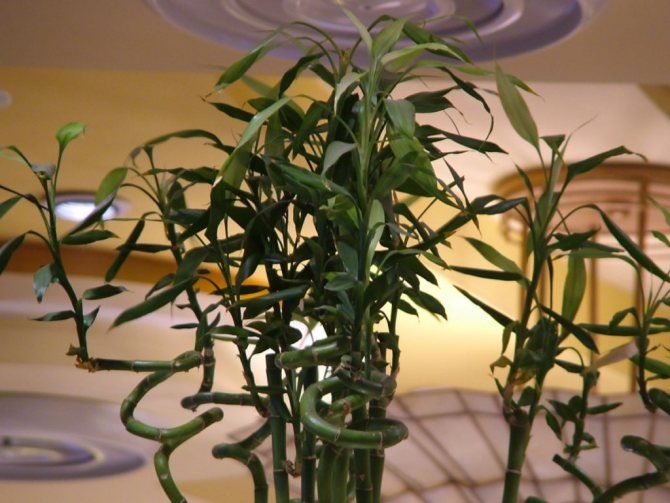
That's just not bamboo at all, but even asparagus! And the plant is called - Dracaena Sander, named after the first European who discovered it.
Types and varieties of bamboo for growing at home
Homes grow mostly low specimens. They can be straight stems or curved. The leaves are predominantly green, but there are varieties with golden foliage. The most common types of indoor bamboo are described below.
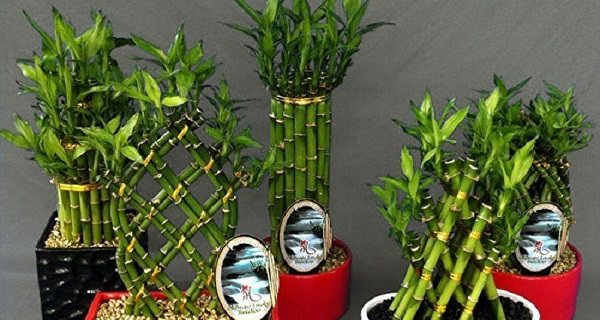

Lucky (tree of happiness)
The most common type. It is a semi-shrub perennial with a bare trunk. At its top are leafy shoots with dense, tough leaves. The species blooms very rarely.
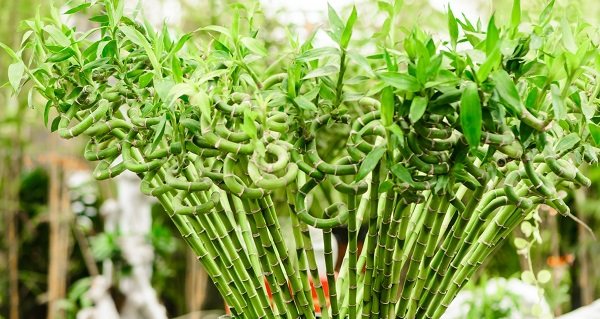

Shiny (nitida)
Tall plant with purple stems. It is grown mainly as a greenhouse culture. Requires a lot of space.
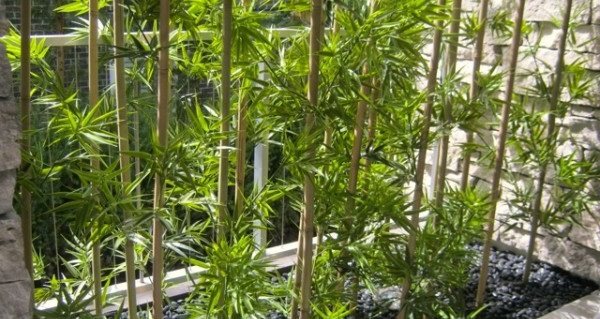

Bluish
Miniature species no more than 0.5 m in height. It is grown as a pot culture.


Motley
Refers to reeds. It has variegated foliage with creamy or whitish stripes. Reaches a height of 1 m.


Kumasaza
View with a zigzag stem. Outwardly it looks like a dwarf bush.
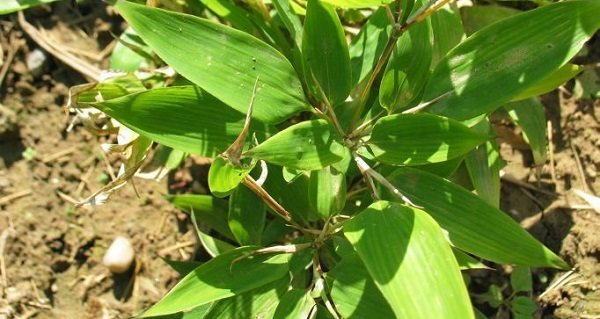

Description of the plant


Indoor bamboo or dracaena Sandera is a perennial ornamental plant with long bare stems of green or straw-golden color, ending at the top with several leaves and shoots. Leaves are dark green, glossy, lanceolate. The plant blooms with white fragrant flowers only once in a lifetime, after 30 years, and only in the wild (see photo). After flowering, the stem dies off.
The subspecies of indoor bamboo differ from each other in shades and height of the stems:
- Medium-sized subspecies native to Japan can reach 4 meters in height. Their leaves are variegated white-green in color. Withstand the bright sun, they are quite demanding on lighting.
- Low-growing subspecies reach a height of no more than 1.5 m and are more suitable for breeding in apartments. Grow well in the shade, cool and high humidity.
Home care
Indoor bamboo is considered an unpretentious plant. But you need to take into account its tropical origin, creating suitable conditions. If you follow the basic rules, growing a crop will not cause any particular difficulties.
Location and lighting
The plant is light-loving. But it can dry out in direct sunlight. Therefore, do not place it right next to the window. It is better to choose a semi-shaded place for the bamboo, where diffused light will be provided to it. It can be created using a translucent curtain. The eastern side of the room would be ideal. With a lack of lighting, the plant may lose its foliage, the crop will slow down.
Indoor bamboo also needs fresh air. The room should have opening vents. But during ventilation, drafts and gusts of strong wind should be avoided.
Content temperature
Although indoor bamboo is a representative of the tropics, it does not tolerate very hot conditions. And if the temperature in the room is above + 35 ° C, it may die. In the spring-summer period, the culture develops better at + 22..24 ° C. It is advisable to provide her with a cool winter - + 14..16 ° С. The temperature must not be allowed to fall below + 12 ° C. Sudden temperature changes are also detrimental to bamboo.
Watering
If indoor bamboo grows in the ground, then it needs regular watering. It is important to maintain constant moisture content. Overdrying and waterlogging of the soil must not be allowed. It is necessary to let the top layer dry a little between waterings. Water for irrigation should be taken only soft, well-separated, without salts. Melt water or rainwater will do. In winter, the amount of watering is reduced.
Air humidity
Although the stem of bamboo is dryish, it needs moderate humidity. Spraying from a spray bottle has a beneficial effect on the plant every 3-4 days. From time to time, you can wipe the leaves with a damp cloth to remove dust. To create a comfortable microclimate, it is recommended to use a humidifier. In winter, place the crop away from heating appliances.
Growing in soil
This is the traditional and more common way. Bamboo grows much better in soil than in water. The mortar can be bought at the store. There are special formulations designed for bamboo dracaena. You can prepare the mixture yourself. Mix 2 parts of clay turf, 1 part each of peat and sand. In general, you can take any soil with an acidity of 5.5-6.5, which is good for air and moisture.
Note! Good drainage is essential. There should be holes at the bottom of the pot for planting, the drainage layer should be ¼ of the pot's volume. Good drainage prevents putrefaction in the root system, the appearance of molds. The container for growing bamboo in the ground must be taken wide, but not deep, since its root system develops almost horizontally.
Growing in water
The tree of happiness can be successfully grown not only in soil, but also in water.
When kept in water, it is necessary to maintain optimal conditions for the life of the culture in a liquid medium. First you need to rinse the roots well. Remove all damaged, rotten areas. You can cut at least 1/3 of the roots. Water for growing is taken only distilled, well-settled.
Select a suitable glass container and place the bamboo in it. Fasten it with sterilized stones of any shape and add water. It is recommended to change it every 1-2 weeks. But if it has become cloudy or the leaf plates have begun to turn yellow, then it is possible earlier. Apply fertilizers intended for dracaena to the water on a monthly basis. Make sure the water level is constant. The roots should not be allowed to bare.
Planting and transplanting
Indoor bamboo is painful for transplants. Therefore, this should not be done unless absolutely necessary. A new pot must be chosen of such a volume that 3-5 cm of stock remains between its walls and the root system.
Transplant procedure:
- Lay a shallow drainage on the bottom of the pot with a layer of at least 2-3 cm.
- Carefully remove the plant from the old pot without damaging the roots. Place it in the center of the new one, fill the voids with soil.
- Avoid strong compaction. It is better to let the soil settle down and add it if necessary. After planting, water the bush abundantly for 10-15 minutes. Drain excess moisture.
Step-by-step video - instructions for planting homemade bamboo:
Top dressing and fertilizers
There is no need to fertilize the plant for several weeks after transplanting. The roots should get stronger. During the growing season, top dressing should be applied at least once every 3 weeks.It is better to use special fertilizers for dracaena for this. Nitrogen fertilizers are useful for building up green mass. In winter, 1-2 additional dressings are enough.
Bloom
Culture blooms only once in a lifetime. It takes all her strength to form flowers. Therefore, after flowering, bamboo usually dies. If an inflorescence still appears at home, then it is better to carefully remove it.
Growing bamboo in the ground


The soil
Ornamental bamboo or dracaena Sander grows much better in soil than in water. Plants do not really like the constant presence of the root part in a humid environment, and water is retained in the soil for a short time. Any soil mixture is suitable for growing. You can purchase the most common one, designed for most indoor flowers. This method of growing and somewhat simplifies the very care of the plant. There is no need to change the soil, like water, every week.
Watering
A significant difference in care is regular and timely watering. The soil in the container with the plant should always be slightly moist, it should not be allowed to dry out. If the dracaena Sander was transferred from the water to the soil, then it is very important to constantly water it and carefully monitor the general condition and development until the bamboo finally takes root in a new place.
Watering in the autumn-winter period should be significantly reduced. It is important to avoid stagnation of water in the ground. This can lead to the formation of mold, which is one of the main enemies of decorative bamboo. In order to prevent this disease, it is recommended not to forget about the drainage layer and drainage holes in the flower pot when planting.
Top dressing and fertilizers
Bamboo grown in the ground also needs timely fertilization in the form of fertilizers for various types of dracaena. They are introduced at intervals of 2-3 months along with irrigation water.
Pruning and shaping the bush
Bamboo treats scraps favorably. They are carried out as needed, giving the bush the desired shape. It is necessary to monitor the basal processes, remove dry and deformed shoots in time. To make the crown more bushy, you need to cut off the tops of the shoots at the branching point. To create the desired shape, it is recommended to tie the stems at the seedling stage using thick wire or twine.
The most popular form of indoor bamboo is with a twisted (spiral) trunk. It takes a lot of time and patience to achieve it. First, the young stalk is planted vertically. At the time of the formation of the kidneys, it is necessary to cover them, leaving only a small window for light to enter. The sprouts will strive for it. To get curls, you need to periodically turn the barrel towards the light.
You can make a special construction out of a cardboard box that can completely cover the bamboo. Make a cutout in it on one side and turn it as the stem grows. The twisting of the stem is possible only by artificial means. It will only grow vertically on its own.
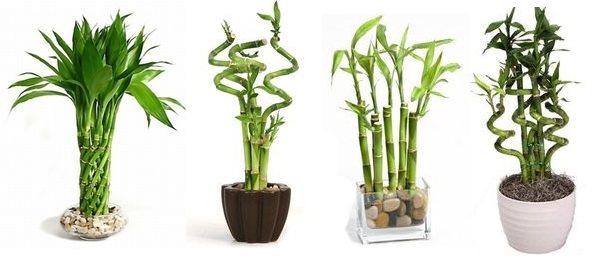

How to bend bamboo


The stems of Dracaena Sander, or indoor bamboo, grow upward if not given the right direction. The peculiarity of this plant is that with the help of improvised means, you can make young shoots twist as you like:
- Push the shoot into a properly bent plastic tube and leave the plant in this position for several weeks. Then carefully remove the tube. The stem will retain the shape given to it.
- Another option is to bend the young stem of the plant in the desired direction and secure it with wire. After a few weeks, the wire can be removed and the stem will remain in the shape it was given.
According to feng shui, the number of bamboo stalks planted at home should be chosen depending on which of the benefits the owner wants to get:
- 3 stems - joy and tranquility.
- 5 stems - material wealth and business prosperity.
- 7 stems - good health and long life.
- 20 stems - mutual love and family happiness.
- 21 stems - well-being in all areas of life.
It is better to avoid other amounts of stems, especially 4 - they can get you in trouble. To enhance the magical properties of indoor bamboo, figures of a frog, panda, elephant, dog are placed in a pot, colored pebbles are poured and the stems are tied with gold and red ribbons.


Indoor bamboo is an exotic plant that has an original and attractive look
The indoor plant bamboo is an evergreen, perennial, with a green fleshy trunk, on which lanceolate leaves are located on top. In nature, it can reach a height of up to several meters; at home, its height is usually limited, preventing it from growing above 1 m - a plant that is too tall loses its decorative appeal, unless we are talking about some very refined shape of the trunk.
In fact, a houseplant, which we usually call "indoor bamboo", looks like a real wild-growing bamboo only outwardly. But in fact it is called Dracaena Sandera and is one of the types of shrub dracaena. In culture, it blooms extremely rarely, with small white flowers that have a sweetish aroma. Indoor bamboo is valued for its decorative appearance, attracting with its green foliage and the ability to form an unusual trunk. And also - if you believe Feng Shui, then it brings good luck and attracts money to the house.


Dracaena Sander in the interior
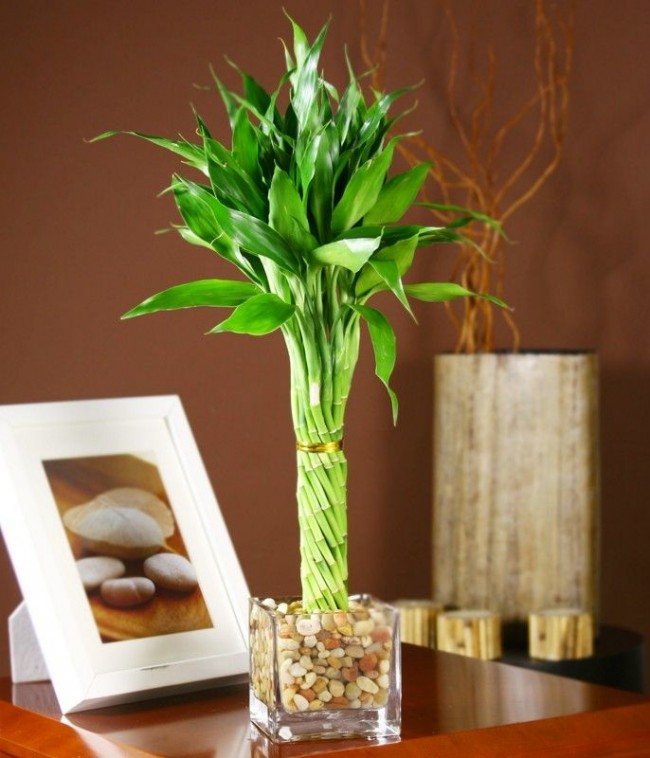

Bamboo will serve as a wonderful decor element
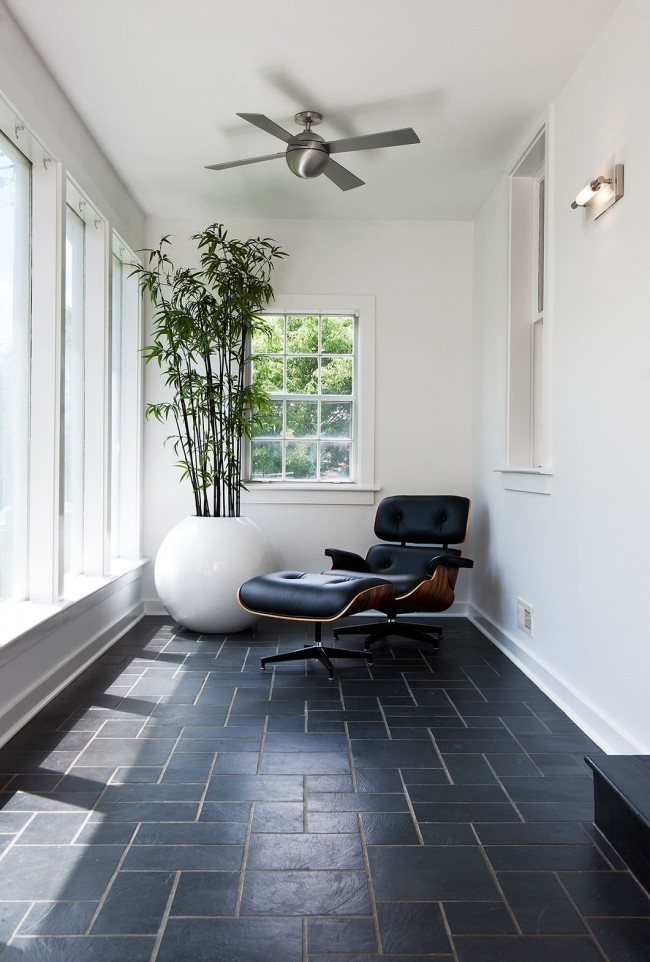

Ball-shaped flowerpot with Dracena in modern design
Reproduction methods
The bamboo dracaena grows very quickly and needs periodic updates. It can be propagated in several ways.
Root division
Carefully separate the processes from the central root with a sharp knife without damaging it. The scion should already have root leaves. Powder the cuts with activated charcoal or treat with garden pitch. Plant the delenki in individual pots, the diameter of which is slightly larger than the root system. The procedure is best done in early spring. In hot weather, the plant does not take root well.
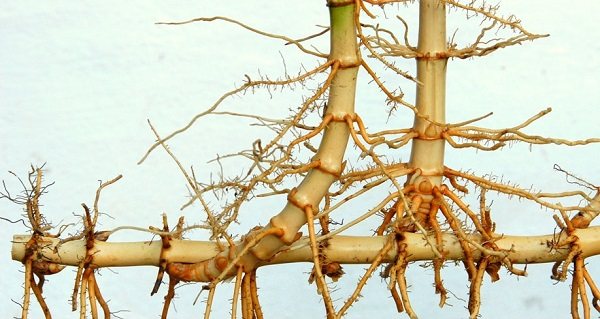

Cuttings
Cut side cuttings, place them in warm water. Cut off part of the cuttings with the phalanx knot. Rooting takes place within 1-1.5 months. You need to change the water regularly. After the roots appear, transplant the plant into suitable soil.
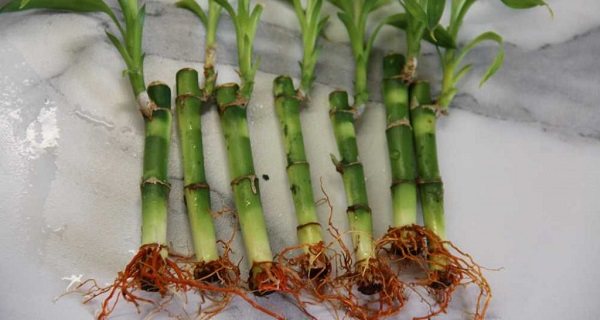

Seed method
This method is used very rarely. This is a complex process that does not always give the desired result. The seeds are pre-soaked in wet gauze so that they germinate. Plant the seedlings in a container with a suitable substrate. Put drainage on the bottom. Cover with plastic wrap to ensure a greenhouse environment. Remove the shelter several times a day for ventilation and spraying. When the seedlings are 5 cm tall, the strongest of them will dive into separate pots.


Nuances of care
Home-planted bamboo needs regular maintenance. Then he will delight with a fresh look, green stems and leaves, and at a certain time with a beautiful flowering. Activities are reduced to watering, moisturizing the foliage, feeding and pruning an adult plant.
Watering
Water the bamboo only with settled water at room temperature. If you moisten the earth with an ordinary tap water, then the harmful impurities contained in it will adversely affect the processes of cultural development. A weakened plant will become a target for attacks by pests and diseases.
In addition to settled water, you can use frozen water. Thus, it softens and cleans up a little. The frequency of watering bamboo varies with the seasons. When it is warm, it is necessary to moisten the ground more often.During the fall-winter period, watering should be moderate. With the arrival of cold weather, the plant is transferred to independent control of moisture needs by transplanting it into a vase of water.
Water the bamboo through the pallet. The roots themselves will take as much moisture as they need. After 3-4 hours, the water is drained. You can find out that it is time to drink the dragon tree by the appearance of the soil surface. Watering at the root is impossible. Also, do not overly moisturize the leaves and stem of the plant. This will lead to the formation of rot on the roots. If a putrid smell emanates from the ground, watering is temporarily stopped.
Transfer
Bamboo grows fast enough and develops its root system. When the roots reach 5 cm in length, the culture can be transplanted. To do this, the stalk is placed in water and left in a lighted place. Too long rhizomes are pruned, because they can get tangled and break off at the very base.
The transplant procedure is as follows:
- the stalk is taken out of the water and treated with a rooting agent;
- the sprout is placed in the hole, gradually adding and tamping the soil;
- The top layer of soil should be flush with the edge of the pot. As it settles after watering, it is added.
Replanting bamboo is best in early spring. So the root system will have time to develop and get stronger. The pot is taken deeper and wider than the previous one.
Top dressing
Even the most nutrients should be in moderation. An excess of fertilizer for bamboo will only do harm. If the plant is planted in the ground, it is fed once a month, starting in spring. In the summer, the amount of fertilizer is minimized, but they are applied a little more often than once a month.
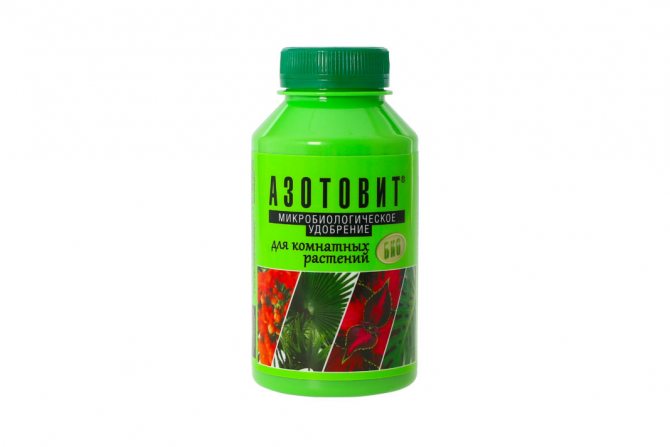

Nitrogen based products can be used to feed bamboo
For feeding decorative dracaena, universal mixtures for palms and deciduous perennials are suitable. If it grows in water, then its nutrition should be complete and frequent. To do this, use liquid products based on nitrogen and phosphorus. If there is no need for the rapid growth of bamboo, the dosage is reduced several times from that indicated on the package.
Pruning
Ornamental bamboo is a unique plant, from the stems of which you can form any shapes. Flexible shoots tolerate pruning well. Carry out it as needed. First of all, get rid of dried leaves and stems at the base. Having chosen the branch point, cut off below its mark.
Cuttings are used for rooting. Small incisions at the bottom of the stem will help speed up the rooting process.
Disease prevention
Bamboo has good immunity and practically does not get sick. The only thing that can happen to him is yellowing of the leaves and tarnishing of the stem. Excessive or improper care can be harmful to the plant. For example, constant intense lighting, irrigation with dirty water, or lack of drainage. This leads to the formation of rot, fungus and bacteria. If small specks appear on the leaves, they are immediately cut off. The cut site is treated with charcoal, and after a couple of hours, it is covered with wax.
Bamboo is rarely susceptible to pest attacks. Sometimes a spider mite can start in it. You can get rid of it by treating it with soapy water.
Features of seasonal care
Indoor bamboo grows intensively in the spring and summer. He needs to provide warmth, regular watering and feeding, bright, diffused light. With the onset of winter, the plant needs rest. Care for him during this period is changing. Watering is reduced to 1 time per week. The air temperature should be at the level of 14-16 degrees. Air humidity should not fall below 40%. Also, bamboo needs to be provided with additional illumination with a fluorescent or phytolamp. With the onset of spring, gradually return the usual care of the plant.
Growing bamboo in water
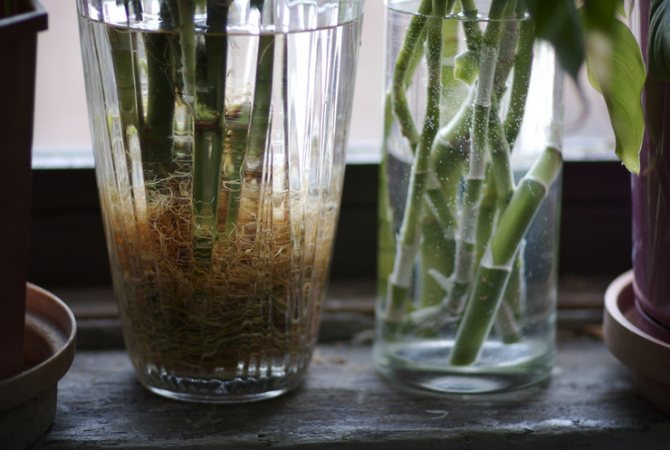

This method of growing decorative bamboo is most suitable and does not take much time to care. The water in the container is changed once a week.For an unpretentious plant, this is quite enough to create optimal conditions for development. This water base contributes to the rapid and harmonious growth of indoor bamboo. Even indoors, exotic bamboo reaches a height of one to two meters. By growing a group of plants in a short time, you can create your own tropical garden.
In the absence of fertilizer, the plant will lose its leafy part or the stem will turn yellow. Fertilization is a very important part of indoor bamboo maintenance. Top dressing is introduced directly into the water, at the time of its replacement with fresh. One feeding every 2-3 months will be enough. It is recommended to use a mineral fertilizer intended for plants of this type.
Several bamboo stems can be grown in one flower container. For convenience and decoration, all plants are tied together with braid of any contrasting color. As a container, you can use not only traditional flower pots or containers, but also glass vases or glasses, and as the bamboo grows - buckets and deep jugs. With a plant height of more than 50-80 centimeters, cultivation vessels are placed only on the floor in the immediate vicinity of a light source or a window.
Water for watering and growing decorative bamboo should be soft. It is advisable to use water that has been settled for several days or melted water. This evergreen plant should not be watered with tap or filtered water.
Preparing melt water:
- Fill a plastic container with water.
- Place in the freezer for 2 days.
- Defrost and use as directed.
Care errors and their elimination
Problems when growing indoor bamboo and how to fix them:
| Problem | The reasons | Decision |
| Slow growth and yellowing of leaves | Nutrient deficiencies, poor lighting | Apply regularly feeding, strictly observing the dosage, rearrange the plant in a bright place |
| Shedding leaves | Lack of moisture | Prevent the substrate from drying out |
| Softness and darkening of leaves | Low air temperature | Normal temperature for bamboo development is + 18-30 degrees |
| Rolling the leaves into tubes | Low moisture, dry soil | Provide regular but moderate watering, spray the leaves, wipe them with a damp cloth |
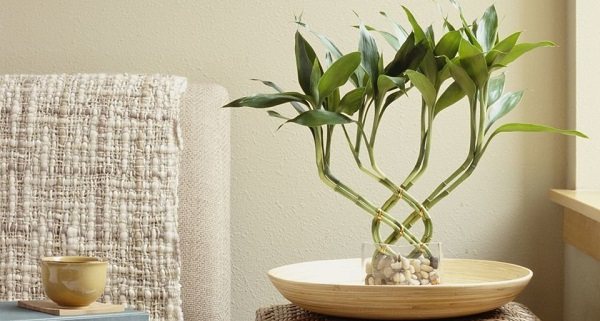

Choosing a place and conditions for keeping indoor bamboo
Lighting. Considering that indoor bamboo does not tolerate direct sunlight and grows well in diffused lighting, it is preferable to choose a place near the eastern window for its content. But it is not recommended to put it on the windowsill; it is better to place the pot on a stand next to the window. The plant does not need additional lighting.
Temperature... Indoor bamboo does not tolerate cold air and drafts. We must try to protect him from this, especially in the winter season. The optimum temperature for keeping the plant should be within + 18- +28 degrees. He does not have a pronounced rest period, so there is no need to change the conditions of detention in the winter.
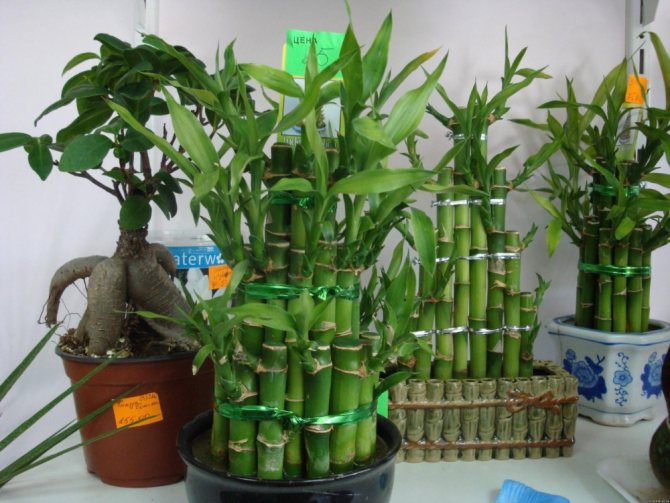

Humidity. Since the plant is native to the tropics, you should try to create additional humidity for the surrounding air. In no case should you put a pot with a plant next to heating appliances. Spraying bamboo is not recommended, as this can lead to rotting of the stems. A good solution is to put a vase of water or an aquarium next to it. Leaves and stems are wiped to remove dust with a cotton pad moistened with water or a sponge.
Planting containers. Depending on the number of stems, the size of the container is selected. If planting is supposed to be in the ground, then any pots with a drainage hole will do, deep enough and wide enough so that the stems can be 5 cm from the edge. For planting in water or in a hydrogel, choose a variety of transparent vases.
Priming. The soil for planting indoor bamboo should be loose, permeable, with a small amount of peat. Ordinary garden soil with 3/1 river sand works well. When planting in the ground at the bottom of the pot, be sure to put drainage at ¼ of the height. Drainage can consist of clay shards, brick debris, expanded clay.
Diseases and pests, control methods
Indoor bamboo is disease resistant. But if it is kept in too humid conditions, as well as in the absence of fresh air, the culture can be struck by a sooty fungus. A diseased plant must be treated with a fungicide and watering should be regulated.
Bamboo pests:
- spider mite;
- aphid;
- mealybug.
The fight against parasites should be started as early as possible. Insecticides will help to effectively deal with pests:
- Aktara;
- Fitoverm;
- Confidor;
- Aktellik and others.
Home bamboo care
Soil and lighting requirements
The soil for "happy bamboo" or dracaena Sander should be loose and moisture-permeable. You can use the ready-made mixture for dracaena.
The soil for real bamboo must be heavy and nutritious. It is recommended to prepare the soil yourself from the following components: 1 share of peat, sand, humus, leaves and 2 shares of clay with turf.
Bamboo is a big fan of light. The plant is able to survive in the sun, but prefers western or eastern windows. If placed on the south window, the leaves of the plant will fade and lose their decorative effect. On the north window, it suffers from a lack of light, does not bush well and loses leaves. In summer, it is advisable to take bamboo out to the balcony, veranda or garden. The plant loves fresh air.
Watering and feeding
In summer, water the bamboo abundantly, while in winter it should be watered sparingly. It is important to ensure that the earthen lump does not dry out. It should be remembered that waterlogging is very dangerous for the plant, so the topsoil should dry out between waterings.
Bamboo can declare its need for watering itself. If its leaves begin to curl, it means that there is not enough moisture, but if the foliage sags, this is a signal of waterlogging of the soil.
Occasionally, bamboo is sprayed with a fine spray, which increases the humidity in the room. It also does not hurt to regularly wipe the leaves of the plant with a damp cloth.
It is recommended to feed bamboo with fertilizers rich in nitrogen and phosphorus. Balanced mineral fertilizers work well. You can apply fertilizers such as "Ideal", "Rainbow" or "Giant". You need to feed it, starting from April and until August, 2 times a month.
Diseases and pests of home bamboo
Diseases of bamboo are associated only with improper care. On its stems and leaves, the appearance of spotting and "rust" is possible. This means that the plant is affected by a fungal disease. It is necessary to treat diseased bamboo with fungicides and establish proper care, as well as regular ventilation.
Bamboo is not too prone to pest infestation, but with poor care it can suffer from spider mites and aphids. If insects are found, remove them with a soapy sponge. If some part of the stem is already affected, it is necessary to cut it off, and treat the remaining healthy parts of the plant with an insecticide. Prevention of pest attacks is the correct watering regime and regular inspection of the plant.
As you can see, such an exotic plant as bamboo is not so difficult to “tame”. The most important thing is to choose the right type, understand the intricacies of care and provide the plant with conditions close to natural.
Have you tried growing your own bamboo grove in a pot? What difficulties did you encounter?
Bamboo in the house: signs and superstitions
This plant has been prized in China since ancient times, where it was endowed with magical qualities.According to the teachings of Feng Shui, it brings success, material well-being and health to the house. It is very important to place the bamboo correctly to get the desired result from it. The best place is the southeastern part of the house. To attract family happiness and love, culture is placed in the bedroom. People who are striving for career growth should put it in their office.
Also, the influence of indoor bamboo depends on the number of stems. If there are three of them, it attracts positive emotions, good luck in all endeavors. Five stems are a symbol of financial well-being. The 7-stem bush will keep its owner healthy and successful. The fulfillment of all desires and the improvement of life aspects is guaranteed by bamboo with 21 stems. A sculpture of a three-legged frog with a coin in its mouth enhances the magical qualities of culture. It is placed next to the plant, but not high. Otherwise it will have the opposite effect. Bamboo should not be allowed to have 4 stems. It gets in trouble.
Indoor bamboo is an exotic plant that many grow to attract financial luck and family well-being to the house. But even those who do not consider themselves superstitious, when creating a favorable microclimate and providing proper care for the plant, will make it an element of living decor that will not leave anyone indifferent.
Do you want to know more useful information about the peculiarities of growing indoor bamboo? Watch the following video:
It is interesting
The real name of indoor bamboo is Dracaena Sander. Despite all its exoticism, home bamboo is considered an unpretentious plant. It is grown both in soil and in water. Dracaena can be used to create incredible compositions. The plant is native to the Asparagus family.
The stem of the bamboo is long and wide. Pouring smooth, shiny, glossy. There is such a rare phenomenon as the flowering of indoor bamboo. This usually happens only once during the entire life period of the plant. But unfortunately after this incredible event, the plant most often withers.
Good to know! In China, dracaena is called "lucky bamboo". In China, bamboo is considered a symbol of happiness and well-being.
In length, bamboo can grow up to 100 centimeters. The stems are green. Experienced growers, while growing bamboo, can give it amazing shapes. For example, you can make the trunk of indoor bamboo in the shape of a spiral.
Types, varieties
Indoor bamboos are classified into two types:
- Large straight-bore. They have a tough stem.
- Herbaceous. They are distinguished by their short stature.
The most popular among flower growers are 4 varieties:
- Saza. It grows up to 2 m, forming a lot of curling greenery at the top. Leaves turn bright green in summer, fade in autumn and winter. The stem is 6-9 mm thick, the leaves are narrow, with pointed ends.
- Fargesia. A dwarf variety up to 50 cm high. As it grows, numerous shoots with bright green glossy leaves are formed on the bushes. The plant is considered frost-resistant.
- Phyllostachis. The stems are in the shape of a cylinder, slightly flattened, can have gray, green, blue-yellow color. Plant height - from 3 to 3.5 m.
- Playblastus. A shade-loving plant, characterized by high frost resistance, can grow well even in a shaded corner of the room. It has convex green leaves up to 30 cm long.
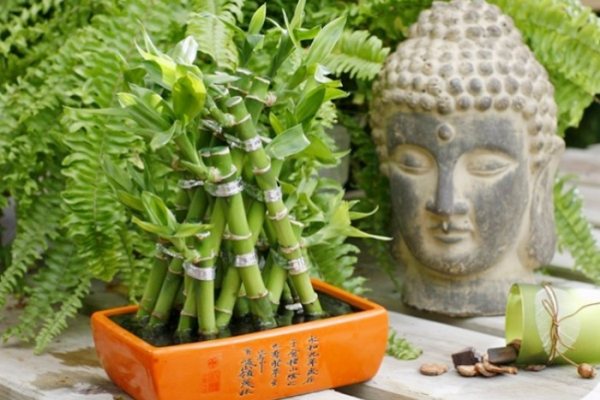

Advice
For those who first decided to purchase bamboo cuttings for growing in water or soil, simple tips from experienced florists will help.
- It is necessary to water the plant with thawed, rain or filtered water, since the tap water contains chlorine, various impurities that slow down photosynthesis. From heavy metals, the leaves are deformed, become pale.
- In winter, watering the pot can be stopped altogether by transplanting the cuttings into a container of water. So the plant itself will control the required volume of liquid.
- If mold, gray or white bloom appears on the surface of the soil, the soil is completely changed, washing the roots before that.
- You can feed the plant not only with granules or purchased solutions, but also with wood ash, chicken droppings, and manure.
Indoor bamboo is a good luck plant!
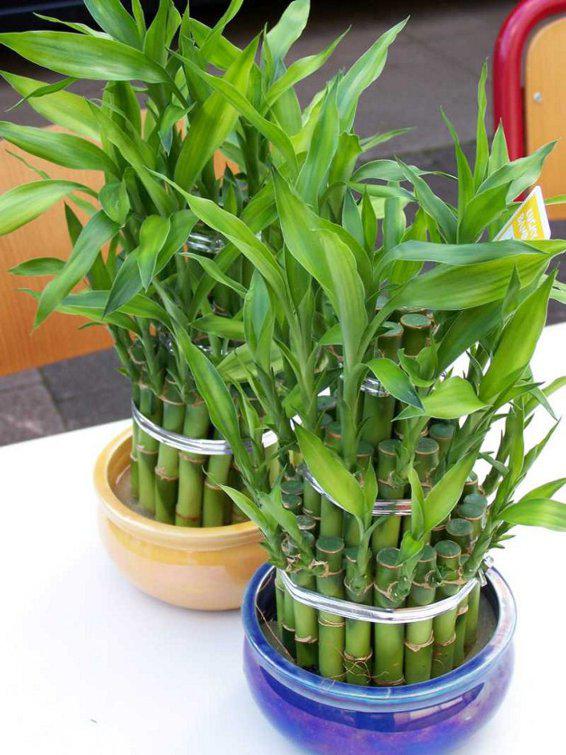

1:502 1:507
Indoor bamboo has been found in many homes in recent years for good reason. Firstly, indoor bamboo has an original, even exotic appearance. Secondly, according to the Feng Shui philosophy, indoor bamboo helps to attract good luck and prosperity to the house.
1:1022 1:1027
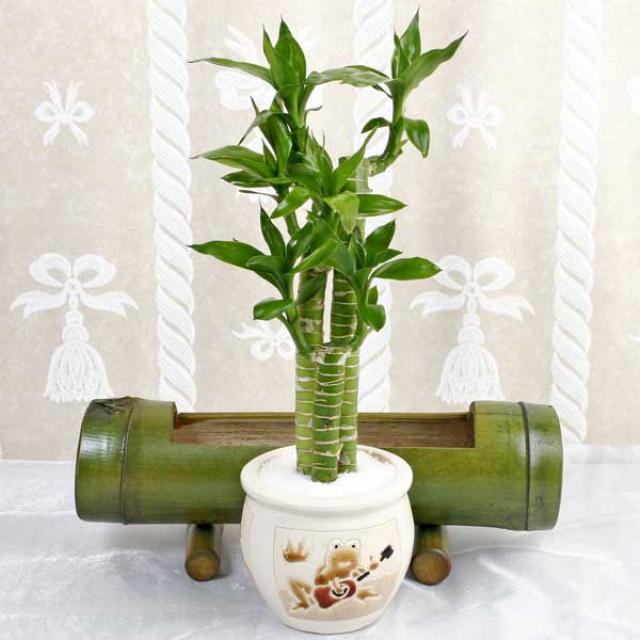

2:1533 2:4
Ornamental bamboo belongs to the houseplant category of the Dracaenaceae family, and has little in common with real woody bamboo.
2:261
The scientific name for indoor bamboo is Dracaena Sanderiana. In fact, the name Dracaena Sanderiana consists of the botanical name Dracaena (by the way, Dracaena is translated as a dragon tree), and the surname of the famous English collector and seller of plants - Frederick Sander (1847-1920), who discovered this amazing plant to the entire civilized world. However, due to its physical resemblance to natural bamboo, this plant is more commonly referred to as ornamental home bamboo or indoor bamboo.
2:1202 2:1207
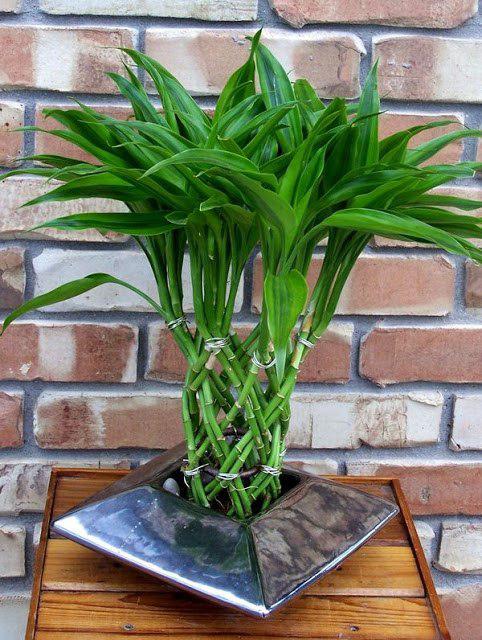

3:1711 3:6
Indoor bamboo care
3:66
Indoor bamboo is pretty easy to grow at home. He is not very whimsical and does not require any special care and attention to himself. The main condition for the successful cultivation of decorative bamboo is timely abundant watering and exclusion of direct sunlight on the plant. With proper care, home bamboo grows up to 70 cm (sometimes up to 2 meters), and serves as a great addition to the room interior.
3:905 3:910
Decorative home bamboo in water
3:987 3:992
Gardeners and houseplant sellers recommend growing ornamental bamboo at home directly in water (or gel), not in soil. This is due to the fact that it is in the water for the growth of indoor bamboo that the most comfortable conditions are created.
3:1451 3:1456


4:1960 4:4
In addition, the constant presence of the root system in water avoids moisture deficiencies, the absence of which is very destructive for ornamental bamboo plants. In fact, the only prerequisite for growing indoor bamboo is moisture. Therefore, water is the most optimal environment for its growth.
4:607 4:612
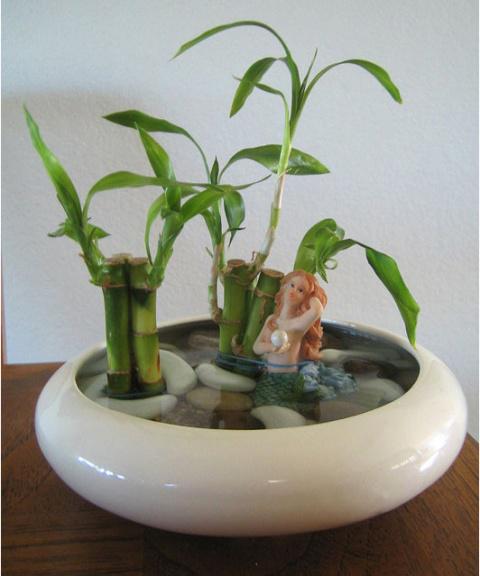

5:1118 5:1123
It is recommended to change the water in the vase with the indoor “bamboo of happiness” at least once a week, and every three months you should add special mineral fertilizers to it, which are necessary for the proper growth and development of the plant. Don't forget this. Indeed, in its natural environment, bamboo receives all its nutrients directly from the soil. At home, if the bamboo is deprived of the necessary nutrition, it will stop growing and shed its leaves.
5:1930 5:4
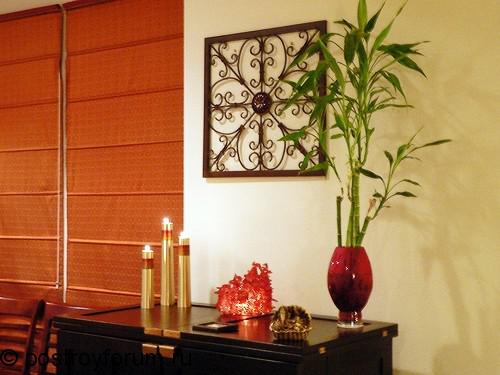

6:508 6:513
It is also important to consider that ordinary tap water is completely unsuitable for indoor bamboo. Moreover, such water is harmful to any indoor plants.
6:825 6:830


7:1334 7:1339
It contains chlorine and biocidal additives that negatively affect the development of the plant, and can lead to its death. It is best to use rain or melt water for irrigation.
7:1678 7:4
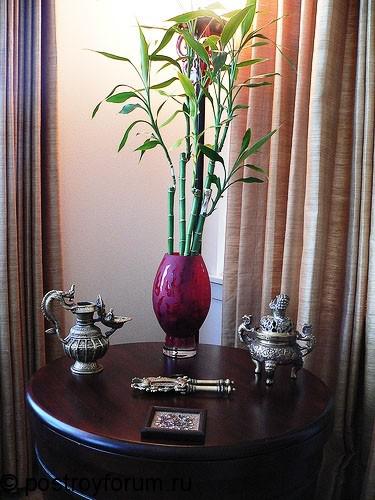

8:508 8:513
Such water can be easily obtained at home. To do this, fill an ordinary plastic bottle with water and put it in the freezer. When the water in the bottle is completely frozen, it should be taken out and left to stand at room temperature. As a result, the water will acquire the necessary softness and can be used to water indoor bamboo.
8:1229
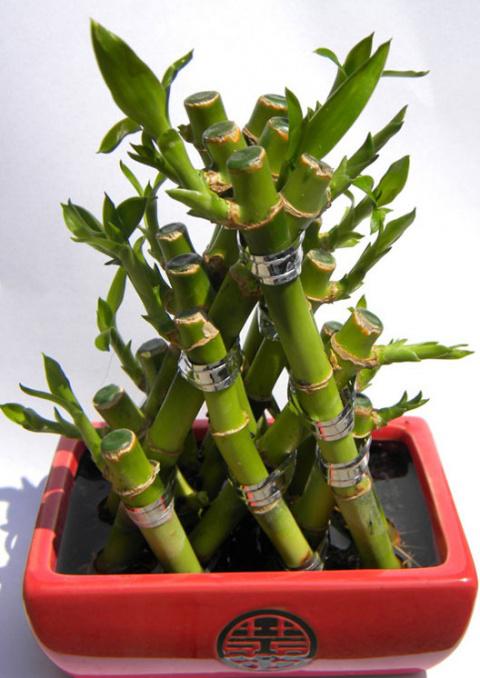

9:1735 9:4
Sometimes, over time, the water takes on an unpleasant odor. It is recommended to replace such water, or in the simplest case, you can add a small amount of charcoal to the water, which has antibacterial properties and excludes the development of bacteria in the aquatic environment, and as a result, the spread of unpleasant odors.
9:615 9:620 10:1124
By the way, if you have a transparent vase with indoor bamboo, then you can additionally decorate it by adding pebbles or colored stones to the bottom.
10:1388 10:1393 10:1396 10:1401
However, they must be pre-rinsed with hot water in order to destroy possible infections and bacteria that may be on their surface, and lead to the fact that your little “piece of happiness” will become sick and wither.
10:1827 10:4


11:508 11:513
Indoor bamboo primer
11:579 11:584
At home, "bamboo of happiness" can be grown in the ground. Moreover, its growth does not require any special soil, but almost any soil for flowers and indoor plants, which is sold in any flower shop, is suitable. Home bamboo grows as well in the ground as in water, and sometimes even better, since bamboo plants do not like stagnant moisture.
11:1282 11:1287
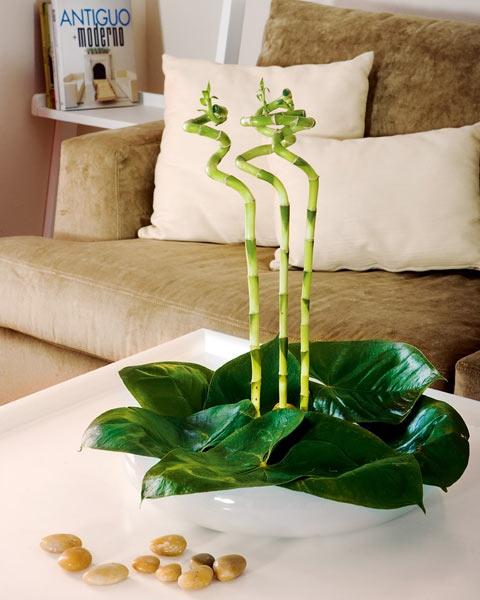

12:1791 12:4
If you do not often change the water in the vase, then this can lead to decay of the root system, which will cause the death of the plant. In the ground, this will not happen, if, of course, you water the plant in a timely manner. Please note that at first, the bamboo flower should be watered more abundantly, since when transplanted from water into soil, its root system is weaker.
12:692 12:697
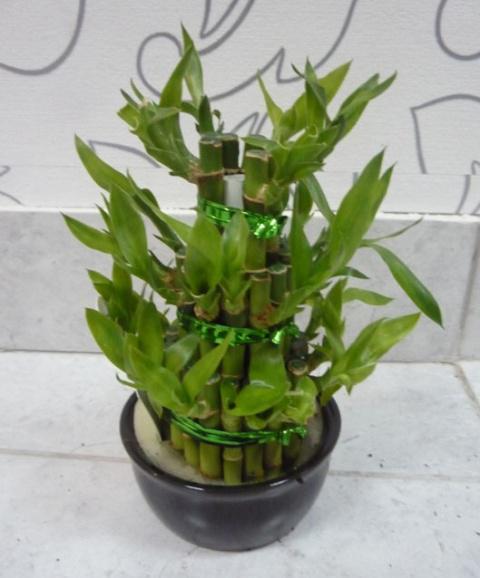

13:1203 13:1208
The only important requirement when breeding Dracena Sander is the mandatory presence of drainage holes in the bottom of the pot. If there are no holes in the pot, then sooner or later this will lead to the formation of mold, which will hit first the roots, and then the whole plant.
13:1734 13:4


14:508 14:513
The bamboo will begin to turn yellow and then dry out altogether. By the way, it is recommended to lay additional drainage from pebbles and expanded clay, which can be bought at any flower shop, at the bottom of the flower pot.
14:893 14:898
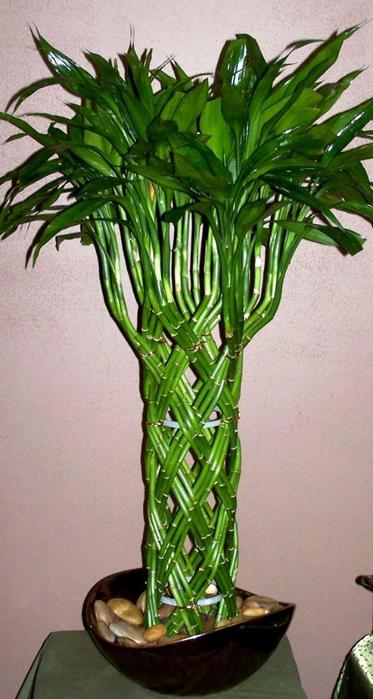

15:1406 15:1411
Watering home bamboo
15:1468 15:1473
Decorative home bamboo needs timely and abundant watering, especially in summer. In cold periods of the year, indoor bamboo should be watered sparingly, as the soil dries, not allowing it to dry out. Watch the plant. If the tips of the leaves begin to turn yellow, then most likely you have violated the watering rules.
15:2072 16:505 16:510
Indoor bamboo lighting
16:577 16:582
When choosing a place for decorative indoor bamboo, avoid sun-drenched windowsill, as well as other places with high solar activity. The leaves of the indoor “bamboo of happiness” are very sensitive to sunlight, under the intense influence of which they can turn yellow and fade.
16:1136 16:1141
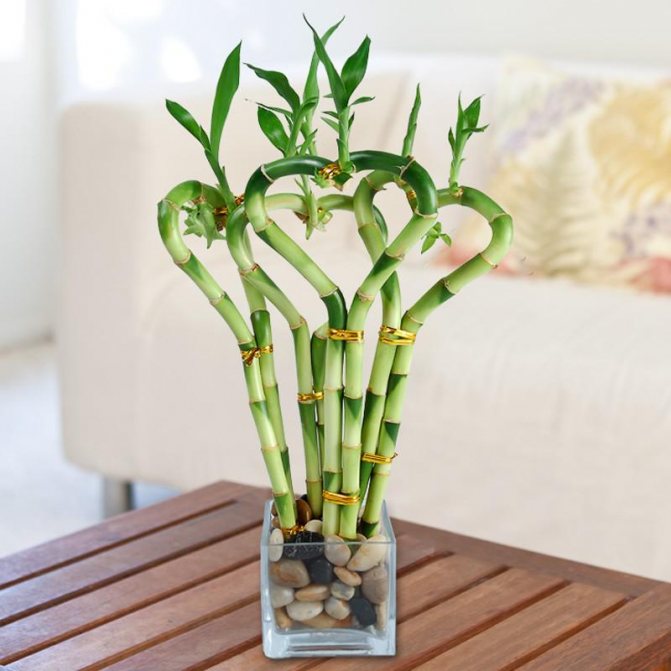

17:1645 17:4
It is better not to put this exotic houseplant on the sunny side of the room, but to place it in partial shade. At the same time, indoor bamboo is not picky about the temperature regime, and feels great at temperatures from +17 C to +35 C.
17:450 17:455
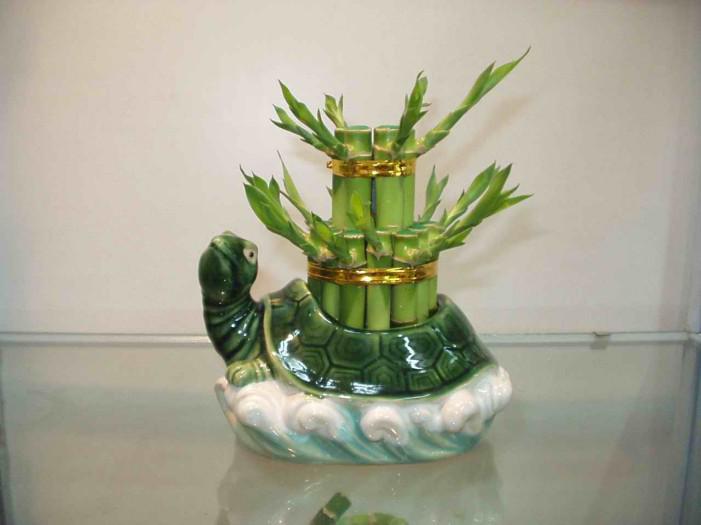

18:959 18:964
Why does bamboo turn yellow?
18:1016 18:1021
Perhaps the only one, but at the same time quite often encountered, is the complaint of the owners of the “lucky bamboo” about the yellowing of the plant. Why is this happening? The cause of the disease of indoor bamboo and its yellowing may be the defeat of the plant by bacteria or fungus. Homemade bamboo can also turn yellow from poor quality water, or the lack of the necessary replenishment in the form of mineral fertilizers. An excess of these same fertilizers can also cause bamboo disease, and as a result, yellowing of its leaves, or even the trunk.
18:2024 18:4
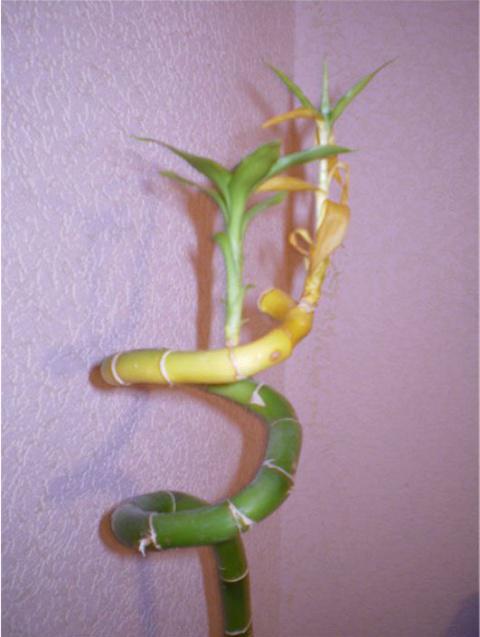

19:510 19:515
In any case, if you notice yellow spots, you need to act immediately. The yellow leaves should be removed. And if a characteristic yellow spot has formed on the stem, then today there is only one effective method of treatment - this is cutting off the diseased section of the stem of the home bamboo. After the “operation,” the cut site should dry out for several hours. Then it should be disinfected using powdered charcoal, and after that, carefully removing excess coal, cover the cut with soft wax.
19:1544 19:4
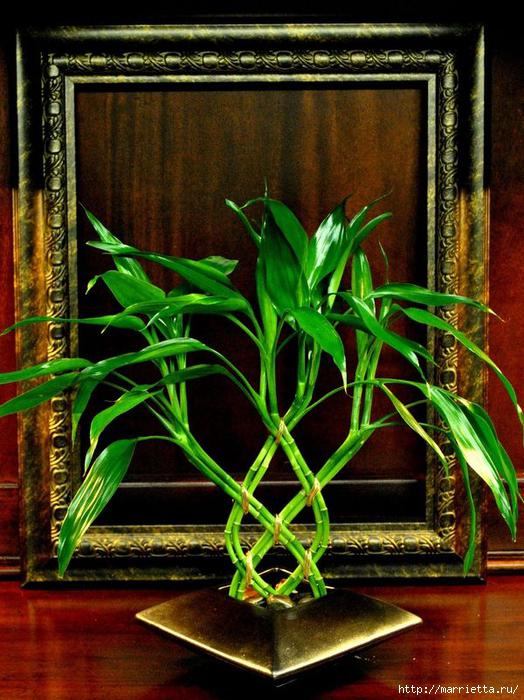

20:508 20:513
Indoor bamboo and feng shui
20:570 20:575
If you believe in feng shui and want indoor bamboo to bring you good luck in business, put it in the southeast part of the room.In addition, organize special care for him so that the egregor of money sees a worthy nourishment in your actions, and plant a talisman next to it - a three-legged toad.
20:1089 20:1094
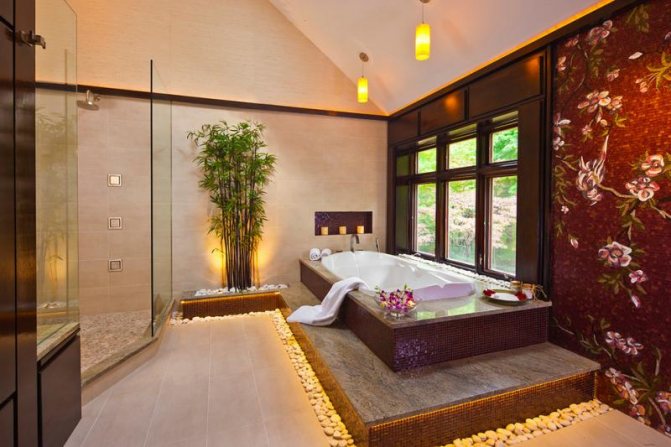

21:1598 21:4



